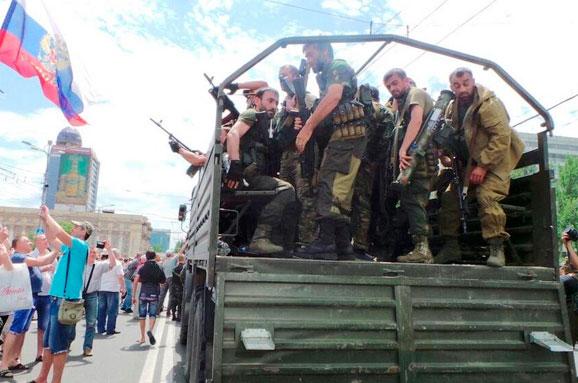The OSCE mission is supposedly one of the few agencies that connect the warring sides of the Donbas war, which has been going on in Eastern Ukraine for more than a year.
But it has not connected terrorists, Ukrainian soldiers, Donbas residents, “Donetsk People’s Republic” supporters and opponents by helping to unravel the Gordian knot of war. On the contrary, it has attracted unanimous hatred of almost all segments of the population from any political background.
Some while ago in Donetsk, the OSCE went through rough times: two protests were held at the luxury hotel where the mission is based; cars were vandalized and then burned, and the people of Donetsk etched the slogan “speak the truth!” into the expensive foreign vehicles of the mission – these protests only fueled the already smoldering flame of hatred for these observers.
Of course, both sides of the conflict view the “truth” from opposite directions. While the locals in Donetsk demand that the OSCE blame Ukraine for all wrongdoing, the territory under Ukrainian control is dissatisfied with the deference the OSCE shows to the “DNR.”
The unproductiveness of the mission in Donetsk and other cities, like Horlivka, is difficult to overstate. So, from August 15 to 17, in Donetsk itself, the terrorists staged a fire show: they hit all areas of the city with everything they could (and in reality, of course, not in accordance with the Minsk agreement): GRAD missiles, shelling, howitzers, and on the outskirts – tanks, as usual.
When I moved from Makiyivka to Donetsk in August, I couldn’t adjust right away to the heavy fire: even while renting an apartment in one of the central districts, almost every night I received a firework show from the trails of red dots the anti-aircraft guns left right over the roof of my house – what is there to say about the outskirts where the “brave republicans” can get away with almost anything? Amid all this, the OSCE itself is based in the most central part of the city, where, even without leaving your hotel, you can clearly hear the firing of shells from the main artillery positions which form a local “Bermuda Triangle”: Shcherbakov Park – train station – airport.
The unproductiveness of the mission is reinforced by its external image. In a city that has been effectively under siege for more than a year, where the majority of remaining residents are forced not to live but to survive, counting every last coin, the OSCE’s expensive cars jam the luxury hotel parking lot on Pushkin Boulevard while mission members feast at restaurants, engendering hatred and negativity among the locals. This hatred is strengthened when OSCE members speak in platitudes, saying stuff like “We have noted some renewed clashes.”
As a rule, such “renewed clashes” in actuality mean incinerated homes in Vetka, nearly 100 explosions in the area of the train station, which lies adjacent to several heavily populated villages, as well as full-fledged fighting in the Spartak region and around the airport. Precisely these circumstances make locals treat mission members with such hostility, because they believe the OSCE mission should be guaranteeing peaceful nights.
Once at one of the Amstor supermarkets in Donetsk, I overheard two Donetsk residents chatting at the seafood counter. One of them, pointing to the rings of dried octopuses for UAH 480 (roughly $22), asked the other in a puzzled manner: “Who can afford this? And they’re imported here!” To which the other answered: “Yeah, who? OSCE members who are probably pigging out in their hotel. Everyone already hates them, even the dill [pejorative term for Ukrainians- ed].”
The image of foreign masters dining in expensive restaurants and from time to time going out on safari to get a feel for the locale never leaves the minds of my fellow residents – and in the majority of cases they are right.
But in a recent statement given by the OSCE mission representative in Donbas, Alexander Hug, the OSCE finally held a more or less unambiguous position, although not concerning the shelling, but regarding attacks on the OSCE itself. Hug unequivocally accused the representatives of the “DNR,” and Zakharchenko in particular, of not fulfilling their obligations to guarantee the safety of mission members, and stating that the last incidents of attack on the OSCE, among which were not only automobile arson, but also the unexploded ammunition that was thrown in the car of the mission at the “republican” roadblock, lie entirely on the conscience of the “DNR” leadership.
“The armed members of the DNR at the roadblock have shown aggression towards the OSCE mission, just like the people who threw unexploded ammunition into the OSCE vehicle,” Hug said.
Interesting that the “republican” journalist who interviewed Hug expressed skepticism that “DNR” soldiers were really involved since anyone could buy camouflage nowadays. Hug answered that the so-called “Minister of Defense of the DNR” Basurin had already admitted to this and apologized for his soldiers.
Despite this, “republican” propaganda tries to represent all attacks on OSCE members as “activities of Ukrainian saboteurs, attempting to achieve the withdrawal of international observers from Donbas.”
In closing, I note that the hotel where the OSCE is located is situated not just in the center of Donetsk, but only a hundred meters from the “government” building of the “DNR” on Pushkin Boulevard, with round-the-clock security, where even at nighttime there are no less than 5-7 soldiers milling around. So the only possible activity in this area is from the side of the “DNR,” and the mission members are well aware of this themselves. The alleged “saboteurs” would have to have been suicide bombers to risk an attack on the OSCE in this place.






